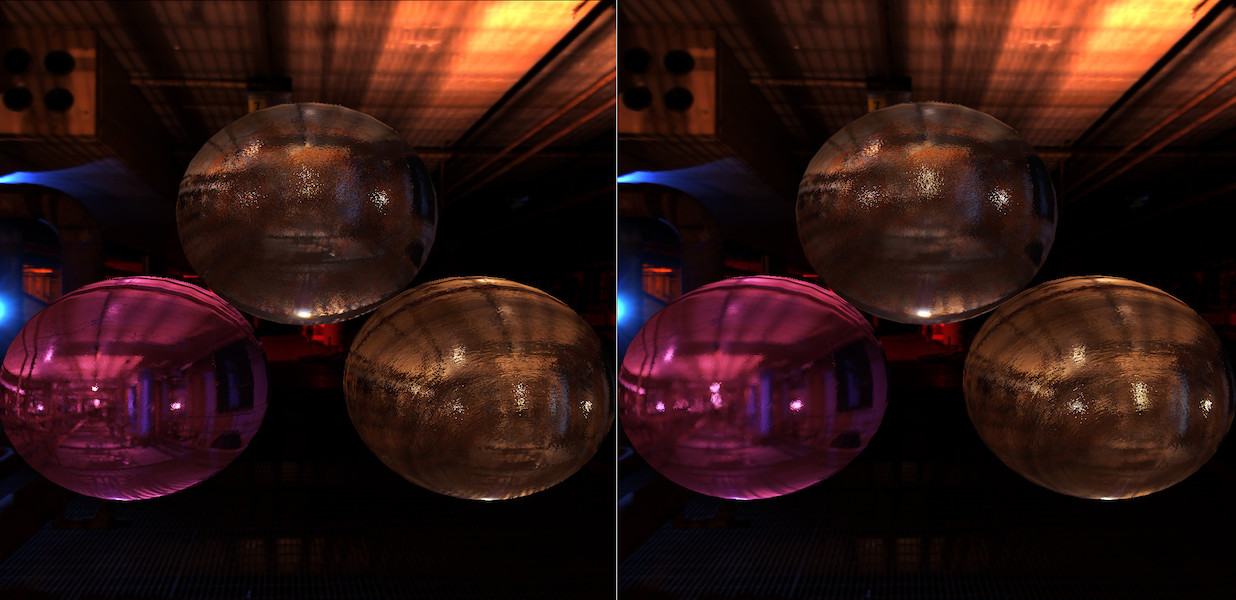Balls!
It’s been a good week for progress.
GL State Cache
The first big thing I achieved was to add GL state caching to CEPL. This has fixed some bugs, avoided some unnecessary state changes and generally made prototyping a bit easier.
For those not familiar that with OpenGL I’ll try explain the whats and whys now. When using OpenGL you are basically working with a crazy vending machine for graphics, you shove what you want draw in one hole, and then flick a bunch of switches and hit go. The switches control ‘how’ it is going to draw. One you have ‘hit go’ it will start rumbling and very soon will have a result. Whilst it is working you can prepare (and start) the next job, setting things up and flicking switches, GL keeps a queue of what it has to go.
The ‘vending machine’ in the above analogy is more formally called the ‘GL state machine’. The state machine has some ‘interesting’ aspects such as:
-
setting some properties on the state machine cause it to have to finish what it was doing before they can be applied, this blocks all queued jobs until that is done. This is really bad for performance
-
querying the properties of the machine is slow. Which means that although changing things can be fast, looking at what you are changing isnt :p
So we want to avoid changing things on the state machine when we can help it, but we can’t afford look at the machine to see if we can avoid changing things.. the solution here is a cache. In the cache we record what we think/know the state of GL is, then when we want to change things we can look at the cache to see if we already have the correct value, and if so, we can avoid requesting the change.
It took a surprisingly long time to get a solution I was happy with in CEPL as I was trying to find a balance between speed and usability. A cache like this can be super useful when debugging as you can look at it and get check your assumptions with the actual state of GL, however working with the raw GL object IDs is (generally) faster. This is also an area where I found the API shaped by the fact I’m in a dynamic programming language, it’s taken some time to find something I’m happy(ish) with.
IBL [0]
After that I went back to trying to implement PBR rendering. I had previously (with help) managed to get point lights working, however I really want to get image based lighting (IBL) in the mix. Now I’ve tried this a few times and have really struggled, partly because the resources available never have a complete example, they are almost always by people with enough rendering experience that they can assume some things to be obvious.. it is almost never obvious to me :p.
This time I went back and attacked this tutorial. Long story short: I don’t believe that the way he is convolving his env maps in the provided code is the way he is doing it in his renders. I made sure that my compiler was producing the EXACT same code as he had and I got completely useless results.
In a fit of desperation I went back onto github searching for any projects that have something working. Many use frameworks like 3js so while they are awesome, they we of limited help. However I did find the following:
-
A 3js project where they have a tonne of the different BRDFs implemented with consistent signatures. This will be a great resource for future learning.
-
A C++ project which has (what looks like) a full implementation of PBR with IBL, using pretty raw DirectX and DXUT (a DirectX equivalent of GLUT). This thing seems to be a perfect resource for me, it’s not an engine, just a project by some person looking to understand a single implementation of this. I’m stoked to be able to read this.
I immediately cloned that C++ project and started reading. They are using the same papers as I have been trying to learn from, however they clearly understood enough to fill in the gaps and (more importantly) pick a selection of approaches that worked together.
I rewrote my env map convolve shader based on what they had AND IT WORKED! The image below shows the same balls taking light from env maps made for two slightly different roughness values. It’s not much but the fact that you can see that the right version has a slightly blurrier ‘reflection’.

I’m now confident that I will be able to get the rest working. More on this in the coming weeks.
Other Stuff
Around this work a bunch of little things got done including:
In CEPL
- Fix a bunch of GL state bugs using the new cache feature
- Start migrating ugly global CEPL state to the cache
- Fix mipmap size bug in texture code
In Varjo
- Generate easier to read GLSL for symbols like π, φ, θ, etc
- Identify and write tests for a bug in function deduplication (not yet fixed). Basically the way I handle global user defined functions is crappy & I need to fix it.
In Nineveh (A library for useful GPU/Rendering functions)
- Add a function that takes a cubemap texture and makes 1 FBO for each mipmap level where the attachments of the fbo are the cube faces at that mipmap level.
That’s all folks
That’s this week done, I really hope I have something visual to show off next week.
Until then, Peace.
[0] Sorry but I won’t try to explain this section simply yet as I don’t understand it well enough yet.